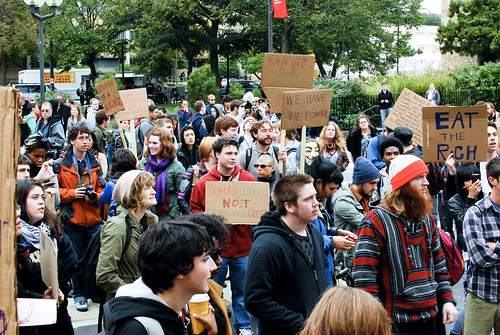
To support Occupy Philadelphia, students walked out of class Friday at noon.
Since local activists and self-described fed-up citizens took to City Hall grounds on Oct. 6, Occupy Philadelphia has attracted college-aged youth with its inclusive message. Two weeks in, on Friday, Oct. 21, students walked out of class to show solidarity with the international Occupy movement.
Senior sociology and political science major Diane Isser, stood in front of the Bell Tower, the rallying point for participants, shortly after noon to address the university community.
“This isn’t just about us, this is about the entire country and the entire world,” Isser said. “The United States is a death machine. We kill all over the world. We kill in this country. We don’t give our citizens health care. And that’s not right.”
“We let people in places like North Philadelphia be unable to feed their children, and although our student debt issues are a huge deal, we need to be cognizant of all other oppressions,” Isser added. Fellow students echoed her statements, a popular technique utilized at the various Occupy protests.
However, the crowd’s message wasn’t supported by all students.
Temple University College Republicans, with pro-capitalism signs, stood behind the crowds, to demonstrate against the movement.
“People are paying money to go to school. I guess that it’s their [choice] not to go,” Erik Jacobs, president of TUCR, said. “I pay money to go to school here, so I go to class. That’s just my opinion.”
The rallying students then marched through campus, before taking to Broad Street for the trek to City Hall. Students from the Community College of Philadelphia also joined the march.
Ralph Young, a history professor with expertise in dissent in America, said he believed student-loan debt and fears of unemployment after college, two things mentioned by the pro-occupy students, were influential in their decision to participate. He said a walkout to mobilize students could be successful in garnering support, if conducted properly.
“It all depends, when they go marching on the protest, on the feeling they give off,” Young said. “If they are acting in a very peaceful and inclusive way, they’re going to be able to get converts.”
Following the walkout and march, students and faculty took to the eighth floor of Anderson Hall for a discussion organized by Young on the local and international protests.
The teach-in, one of Young’s weekly meeting to openly discuss current issues, was hosted by senior neuroscience major Rand Williamson, freshman university studies major Mary Chase and sophomore environmental studies major Gabrielle Taube. The three students were arrested at the movement’s origin, New York City, while storming the Brooklyn Bridge with more than 700 others with Occupy Wall Street, on Oct. 1.
At the meeting, James Lammendola, a legal studies professor, said “too many people in the United States don’t realize there is a problem with inequality of wealth and inequality of resources.”
“You need more people in the streets, more people to realize there’s a problem,” Lammendola said.
He added that there needs to be more ethics in laws.
“The only way I can see that some of this disparity can be addressed and somewhat alleviated is through a strong government response that would work in favor of the protestors,” Young said.
Evan Hoffmann, a 2005 alumnus, said he feared the movement would fizzle out over the following months.
As a result, some attendees entertained the idea of another revolution, which sparked a short debate about the possibility of citizens arming themselves.
“A revolution would go nowhere. I think that’s just a lot of frustration,” Young said after the meeting, comparing it to the American Revolution. “It was 10 years of protests against the stamp tax and the tea tax and all these other things before real hostility broke out, and that was at a time when weapons weren’t quite the same.”
The lifespan of the movement, often brought into question by criticizers, was discussed by those at the teach-in.
Young said history can lend a hand to protestors.
“If protestors look at the history of other protests, they can certainly pick up tips of ways to go about constructive protests that are going to expand,” he said.
Angelo Fichera can be reached at afichera@temple.edu.



Why don’t we have Economics professors speak to these guys and not history professors?
And the last thing we need is angry armed Occupy protesters.